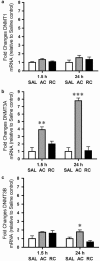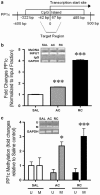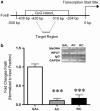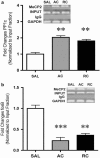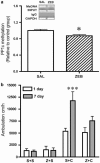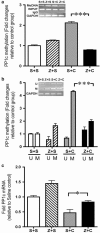DNA methylation regulates cocaine-induced behavioral sensitization in mice - PubMed (original) (raw)
DNA methylation regulates cocaine-induced behavioral sensitization in mice
Kaili Anier et al. Neuropsychopharmacology. 2010 Nov.
Abstract
The behavioral sensitization produced by repeated cocaine treatment represents the neural adaptations underlying some of the features of addiction in humans. Cocaine administrations induce neural adaptations through regulation of gene expression. Several studies suggest that epigenetic modifications, including DNA methylation, are the critical regulators of gene expression in the adult central nervous system. DNA methylation is catalyzed by DNA methyltransferases (DNMTs) and consequent promoter region hypermethylation is associated with transcriptional silencing. In this study a potential role for DNA methylation in a cocaine-induced behavioral sensitization model in mice was explored. We report that acute cocaine treatment caused an upregulation of DNMT3A and DNMT3B gene expression in the nucleus accumbens (NAc). Using methylated DNA immunoprecipitation, DNA bisulfite modification, and chromatin immunoprecipitation assays, we observed that cocaine treatment resulted in DNA hypermethylation and increased binding of methyl CpG binding protein 2 (MeCP2) at the protein phosphatase-1 catalytic subunit (PP1c) promoter. These changes are associated with transcriptional downregulation of PP1c in NAc. In contrast, acute and repeated cocaine administrations induced hypomethylation and decreased binding of MeCP2 at the fosB promoter, and these are associated with transcriptional upregulation of fosB in NAc. We also found that pharmacological inhibition of DNMT by zebularine treatment decreased cocaine-induced DNA hypermethylation at the PP1c promoter and attenuated PP1c mRNA downregulation in NAc. Finally, zebularine and cocaine co-treatment delayed the development of cocaine-induced behavioral sensitization. Together, these results suggest that dynamic changes of DNA methylation may be an important gene regulation mechanism underlying cocaine-induced behavioral sensitization.
Figures
Figure 1
Cocaine-induced behavioral sensitization. Mice were treated daily for 7 days and ambulation was recorded for 1 h immediately after treatment. Treatment groups: SAL, mice were treated with saline; AC, mice were treated with saline for 6 days and with cocaine (15.0 mg/kg i.p.) on the seventh day; RC, mice were treated daily for 7 days with cocaine. Two-way ANOVA with repeated measures, followed by Bonferroni post-test, **p<0.01 AC first vs seventh day, ***p<0.001 RC first vs seventh day, _n_=11. Error bars indicate SEM.
Figure 2
Acute cocaine treatment was associated with an upregulation of DNMT3A and DNMT3B mRNA levels in the NAc, using a quantitative real-time PCR. (a–c) Cocaine effect on DNMT1, DNMT3A, and DNMT3B mRNA levels at 1.5 and 24 h after treatment in the NAc. One-way ANOVA, followed by Bonferroni post-test, *p<0.05, **p<0.001, ***p<0.0001 compared with saline (SAL) group, _n_=11. Error bars indicate SEM.
Figure 3
Altered patterns of PP1c, fosB, and A2AR gene expressions after cocaine treatment in the NAc. (a) The effect of acute (AC) and repeated cocaine (RC) administration on PP1c mRNA levels at 1.5 and 24 h after treatment, using quantitative real-time PCR. (b) AC and RC treatment resulted in decrease of PP1c protein level 24 h after treatment in the NAc, using western blot analysis. (c) The effect of AC and RC administration on fosB mRNA levels, using quantitative real-time PCR. (d) The effect of AC and RC administration on A2AR mRNA levels, using quantitative real-time PCR. One-way ANOVA, followed by Bonferroni post-test, *p<0.05, #p<0.001 compared with saline (SAL) group, _n_=11. Error bars indicate SEM. OD, optical density.
Figure 4
Cocaine treatment was associated with altered DNA methylation at PP1c promoters in the NAc at 24 h after treatment. (a) The position of the PP1c promoter-associated CpG island is indicated relative to transcription start site. The target region indicates the locations of MSP qPCR primer pairs. (b) Acute (AC) and repeated cocaine (RC) treatment elicited DNA hypermethylation associated with the PP1c promoter region, using MeDIP assay. One-way ANOVA, followed by Bonferroni post-test, ***p<0.001 compared with saline (SAL) group, _n_=6. (c) AC and RC treatment elicited hypermethylation associated with the PP1c promoter region, using MSP qPCR. Two-way ANOVA followed by Bonferroni post-test, *p<0.05, ***p<0.001 compared with methylated SAL group, _n_=11. Error bars indicate SEM. M, methylated; MeDNA, methylated DNA; U, unmethylated.
Figure 5
Cocaine treatment was associated with altered DNA methylation at fosB promoters in the NAc at 1.5 h after treatment. (a) The position of the fosB promoter-associated CpG island is indicated relative to transcription start site. The target region indicates the locations of the qPCR primer pairs. (b) Acute (AC) and repeated cocaine (RC) treatment elicited DNA hypomethylation associated with the fosB promoter region, using MeDIP assay. One-way ANOVA, followed by Bonferroni post-test, ***p<0.001 compared with saline (SAL) group, _n_=6. Error bars indicate SEM. MeDNA, methylated DNA.
Figure 6
Altered patterns of MeCP2 binding at PP1c and fosB promoter regions in the NAc, using ChIP assay. (a) Acute (AC) and repeated cocaine (RC) treatment increased MeCP2 binding at the PP1c promoter region relative to the saline (SAL) group at 24 h after treatment. (b) AC and RC treatment decreased MeCP2 binding at the fosB promoter region at 1.5 h after treatment. One-way ANOVA, Bonferroni post-test, **p<0.01, ***p<0.001 relative to SAL, _n_=6. Error bars indicate SEM.
Figure 7
Inhibition of DNMT by zebularine delayed cocaine-induced behavioral sensitization. (a) Acute zebularine (ZEB) (300 ng per 0.5 μl, i.c.v.) treatment elicited DNA hypomethylation associated with the PP1c promoter region at 1.5 h after treatment in the NAc, using MeDIP assay. _T_-test, *_p_=0.034, _n_=4. (b) Mice were treated with cocaine (15.0 mg/kg, i.p.) alone or co-treated with zebularine (300 ng per 0.5 μl, i.c.v.) daily for 7 days, and their ambulation was recorded for 1 h immediately after treatment. Mice were treated with saline (0.5 μl, i.c.v.)+saline (0.1 ml per 10 g body weight, i.p.) (S+S); zebularine i.c.v.+saline i.p. (Z+S); saline i.c.v.+cocaine i.p. (S+C); or zebularine i.c.v.+cocaine i.p. (Z+C). Two-way ANOVA with repeated measures, followed by Bonferroni post-test, ***p<0.001 S+C first vs seventh day, _n_=7–12. Error bars indicate SEM. MeDNA, methylated DNA.
Figure 8
Inhibition of DNMT by zebularine altered DNA methylation at the PP1c promoter region 24 h after treatment in the NAc. Mice were treated with saline (0.5 μl, i.c.v.)+saline (0.1 ml per 10 g body weight, i.p.) (S+S); zebularine i.c.v.+saline i.p. (Z+S); saline i.c.v.+cocaine i.p. (S+C); or zebularine i.c.v.+cocaine i.p. (Z+C). (a) Repeated Z+C co-treatment decreased DNA methylation level associated with the PP1c promoter relative to the S+C group. (b) Repeated Z+C treatment decreased DNA methylation level associated with the PP1c promoter relative to the S+C group. Two-way ANOVA followed by Bonferroni post-test, ***p<0.001 methylated S+C vs methylated Z+C, _n_=5–7. (c) The blockade of PP1c methylation by zebularine was associated with an enhanced PP1c mRNA level. One-way ANOVA followed by Bonferroni post-test *p<0.05 S+C vs Z+C, _n_=5–7. Error bars indicate SEM. M, methylated; U, unmethylated; MeDNA, methylated DNA.
Similar articles
- The role of DNA methyltransferase activity in cocaine treatment and withdrawal in the nucleus accumbens of mice.
Urb M, Niinep K, Matsalu T, Kipper K, Herodes K, Zharkovsky A, Timmusk T, Anier K, Kalda A. Urb M, et al. Addict Biol. 2020 Jan;25(1):e12720. doi: 10.1111/adb.12720. Epub 2019 Feb 7. Addict Biol. 2020. PMID: 30730091 - S-adenosylmethionine modifies cocaine-induced DNA methylation and increases locomotor sensitization in mice.
Anier K, Zharkovsky A, Kalda A. Anier K, et al. Int J Neuropsychopharmacol. 2013 Oct;16(9):2053-66. doi: 10.1017/S1461145713000394. Epub 2013 May 20. Int J Neuropsychopharmacol. 2013. PMID: 23684129 - Cocaine represses protein phosphatase-1Cβ through DNA methylation and Methyl-CpG Binding Protein-2 recruitment in adult rat brain.
Pol Bodetto S, Carouge D, Fonteneau M, Dietrich JB, Zwiller J, Anglard P. Pol Bodetto S, et al. Neuropharmacology. 2013 Oct;73:31-40. doi: 10.1016/j.neuropharm.2013.05.005. Epub 2013 May 18. Neuropharmacology. 2013. PMID: 23688924 - Cocaine-induced epigenetic DNA modification in mouse addiction-specific and non-specific tissues.
Anier K, Urb M, Kipper K, Herodes K, Timmusk T, Zharkovsky A, Kalda A. Anier K, et al. Neuropharmacology. 2018 Sep 1;139:13-25. doi: 10.1016/j.neuropharm.2018.06.036. Epub 2018 Jun 28. Neuropharmacology. 2018. PMID: 29964092 - Reflections on: "A general role for adaptations in G-Proteins and the cyclic AMP system in mediating the chronic actions of morphine and cocaine on neuronal function".
Nestler EJ. Nestler EJ. Brain Res. 2016 Aug 15;1645:71-4. doi: 10.1016/j.brainres.2015.12.039. Epub 2015 Dec 29. Brain Res. 2016. PMID: 26740398 Free PMC article. Review.
Cited by
- How to prevent the malignant progression of bipolar disorder.
Post RM. Post RM. Braz J Psychiatry. 2020 Sep-Oct;42(5):552-557. doi: 10.1590/1516-4446-2020-0874. Braz J Psychiatry. 2020. PMID: 32578689 Free PMC article. - Epigenetics and psychostimulant addiction.
Schmidt HD, McGinty JF, West AE, Sadri-Vakili G. Schmidt HD, et al. Cold Spring Harb Perspect Med. 2013 Mar 1;3(3):a012047. doi: 10.1101/cshperspect.a012047. Cold Spring Harb Perspect Med. 2013. PMID: 23359110 Free PMC article. Review. - Regulation of dopamine-dependent transcription and cocaine action by Gadd45b.
Zipperly ME, Sultan FA, Graham GE, Brane AC, Simpkins NA, Carullo NVN, Ianov L, Day JJ. Zipperly ME, et al. Neuropsychopharmacology. 2021 Mar;46(4):709-720. doi: 10.1038/s41386-020-00828-z. Epub 2020 Sep 14. Neuropsychopharmacology. 2021. PMID: 32927466 Free PMC article. - Epigenetic Neuropharmacology: Drugs Affecting the Epigenome in the Brain.
Toth M. Toth M. Annu Rev Pharmacol Toxicol. 2021 Jan 6;61:181-201. doi: 10.1146/annurev-pharmtox-030220-022920. Epub 2020 Sep 30. Annu Rev Pharmacol Toxicol. 2021. PMID: 32997604 Free PMC article. Review. - Cocaine-mediated downregulation of microglial miR-124 expression involves promoter DNA methylation.
Guo ML, Periyasamy P, Liao K, Kook YH, Niu F, Callen SE, Buch S. Guo ML, et al. Epigenetics. 2016 Nov;11(11):819-830. doi: 10.1080/15592294.2016.1232233. Epub 2016 Oct 27. Epigenetics. 2016. PMID: 27786595 Free PMC article.
References
- Amir RE, Van den Veyver IB, Wan M, Tran CQ, Francke U, Zoghbi HY. Rett syndrome is caused by mutations in X-linked MECP2, encoding methyl-CpG-binding protein 2. Nat Genet. 1999;23:185–188. - PubMed
- Berke JD, Hyman SE. Addiction, dopamine, and the molecular mechanisms of memory. Neuron. 2000;25:515–532. - PubMed
- Bestor TH. The DNA methyltransferases of mammals. Hum Mol Genet. 2000;9:2395–2402. - PubMed
- Bird A. DNA methylation patterns and epigenetic memory. Genes Dev. 2002;16:6–21. - PubMed
- Brami-Cherrier K, Roze E, Girault JA, Betuing S, Caboche J. Role of the ERK/MSK1 signalling pathway in chromatin remodelling and brain responses to drugs of abuse. J Neurochem. 2009;108:1323–1335. - PubMed
Publication types
MeSH terms
Substances
LinkOut - more resources
Full Text Sources
Miscellaneous

